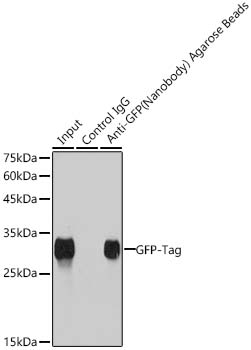Description
Anti-GFP VHH Magnetic Beads
The Agarose Beads Conjugated Anti-GFP VHH Single Domain Antibody (CABE074) is a versatile tool for researchers studying proteins tagged with GFP (Green Fluorescent Protein). This antibody, conjugated to agarose beads, allows for easy purification and immunoprecipitation of GFP-tagged proteins from various samples.Using a single domain antibody derived from llama, the CABE074 antibody is highly specific and efficient in capturing GFP-tagged proteins for downstream analysis. The agarose beads conjugated to the antibody provide a solid support matrix for easy handling and separation of the target protein.
The GFP VHH single domain antibody is widely used in cell biology, molecular biology, and protein research applications. It is suitable for immunoprecipitation, protein purification, and protein-protein interaction studies involving GFP-tagged proteins.Overall, the Agarose Beads Conjugated Anti-GFP VHH Single Domain Antibody (CABE074) offers a reliable and convenient solution for researchers looking to isolate and study GFP-tagged proteins in their experiments.
| Product Name: | Anti-GFP VHH Magnetic Beads |
| SKU: | CABE074 |
| Size: | 100uL |
| Isotype: | VHH |
| Host Species: | Alpaca |
| Reactivity: | Species independent |
| Immunogen: | Recombinant protein of GFP. |
| Tested Applications: | IP ChIP RIP CoIP |
| Recommended Dilution: | IP,30μl Anti-GFP(Nanobody) Agarose Beads antibody for 100μg extracts of recombinant proteinCoIP,500 μL (20 reactions)RIP,500 μL (20 reactions)ChIP,500 μL (20 reactions) |
| Synonyms: | GFP;GFP tag;GFP-tag |
| Conjugate: | Agarose Beads |
| Calculated MW: | 27kDa |
| Observed MW: | 30kDa |
The green fluorescent protein (GFP) is a protein composed of 238 amino acid residues (26.9 kDa) that exhibits bright green fluorescence when exposed to light in the blue to ultraviolet range. Although many other marine organisms have similar green fluorescent proteins, GFP traditionally refers to the protein first isolated from the jellyfish Aequorea victoria. The GFP from A. victoria has a major excitation peak at a wavelength of 395 nm and a minor one at 475 nm. Its emission peak is at 509 nm, which is in the lower green portion of the visible spectrum. The GFP from the sea pansy (Renilla reniformis) has a single major excitation peak at 498 nm. GFP makes for an excellent tool in many forms of biology due to its ability to form internal chromophore without requiring any accessory cofactors, gene products, or enzymes / substrates other than molecular oxygen.In cell and molecular biology, the GFP gene is frequently used as a reporter of expression. It has been used in modified forms to make biosensors, and many animals have been created that express GFP, which demonstrates a proof of concept that a gene can be expressed throughout a given organism, in selected organs, or in cells of interest. GFP can be introduced into animals or other species through transgenic techniques, and maintained in their genome and that of their offspring. To date, GFP has been expressed in many species, including bacteria, yeasts, fungi, fish and mammals, including in human cells.
| Purification Method: | Affinity purification |
| Storage Buffer: | Store at 4℃. Avoid freeze / thaw cycles.Buffer: 0.03% sodium azide,20% ethanol |








